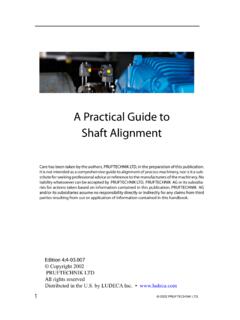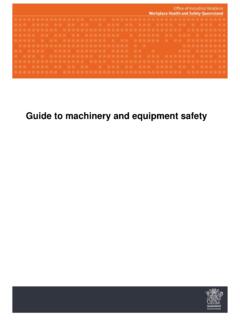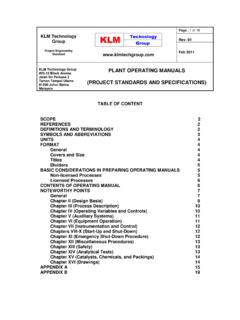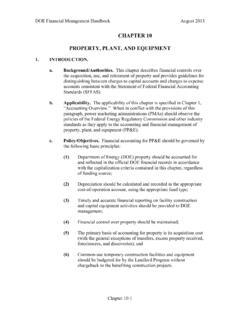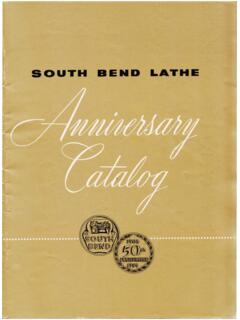Transcription of Plant or machinery capital allowances - GOV.UK
1 The Energy Technology List (ETL) and Enhanced capital allowance (ECA) SchemePlant or machinery capital allowances :1 Introduction This presentation provides high level information about Plant and machinery tax capital allowances . The presentation is divided into sections that answer the following questions:What are capital allowances ?How do I claim an ECA?Additional information123 Plant or machinery1 What are capital allowances ?2 You can claim capital allowances when you buy assets that you keep to use in your business, : equipment machineryThese are known as Plant and machinery . You can deduct some or all of the value of the item from your profits before you pay more informationCapital allowancesCapital allowance and depreciation are for different purposes: Depreciation is an accounting concept.
2 It is a method of reallocating the cost of a tangible asset over its useful life span. capital allowance is a tax concept. It is a method of reallocating the taxable benefit of a tangible asset over its useful life span. Depreciation is not allowed as a deduction for tax purposes, and must be added back to net profit for tax purposes. A capital allowance is given instead of depreciation for certain types of asset. capital allowances are the sums of money a UK business can deduct from the overall corporate or income tax on its profits. 4 See more informationCapital allowance vs depreciation Qualifying costs include the cost of buying the equipment as well as other direct costs involved, such as the installationand transportation costsof the purchased equipment (see ETL Technology Criteriafor further details).
3 For Biomass Boilers, the Scope of the Claim in the ETL criteria (updated 2016) is:Scope of Claim Expenditure on the provision of Plant and machinery can include not only the actual costs of buying the equipment, but other direct costs such as the transport of the equipment to site, and some of the direct costs of installation. Clarity on the eligibility of direct costs is available from HMRC. The invoiced cost of the equipment is normally the amount claimed. Where there is a piece of equipment that is eligible for an ECA, an ETL listed motor, which is part of a larger piece of equipment that isn t on the ETL, then if the price of the motor cannot be separated out on the invoice, then the ETL Claims Values document could be used.
4 See: costs6 Plant or machinery capital allowance choices Businesses can write off 100% of the qualifying costs on eligible Plant and machinery against the taxable profits in the first-year, the year the investment is made. There is no cap on the amount that profit making businesses can claim. There is a cap on the amount that can be claimed by loss making businesses*.Enhanced capital allowance (ECA) Businesses can write off 18% (or 8% for some technologies, Special Pool Rate ) of the qualifying costs against the taxable profits per year on a reducing balance basis. Relief is spread over several Down allowances (WDA) Businesses can write off 100% of the qualifying costs on eligible Plant and machinery against the taxable profits in the first-year, the year the investment is made.
5 The AIA is capped. From 1 January 2016 the AIA was capped at 200, Investment allowance (AIA)*The Government announced at Autumn Budget 2017 an extension to the lifespan of the tax relief for loss making businesses (who purchase items from the ETL). The rate claimable will now be two-thirds of the Corporation Tax is up to each business to select the appropriate tax option for its particular circumstance. In choices as to which capital allowance option to pursue a business should take financial advice from its tax ECA value in the year of purchase is nearly 6 timesthe value of the standard capital allowance (CA); and times the value of the special rate pool CA.
6 And is the same as the AIA7 Visual comparison between tax relief optionsTax relief for 25,000 of spending on qualifying purchases050001000015000200002500030000 ECA (100%)Standard CA(18%)Special RatePool CA (8%)AnnualInvestmentAllowance(100%)Expen diture ( )Tax relief in year of purchaseTotal expenditureThe Standard CA and the Special Rate Pool CA can be claimed in future years. If a business incurs no more than 200,000 qualifying expenditure in an accounting period, they would probably choose to claim the AIA for all of the expenditure (as this is an easier option than working out whether the conditions for ECAs are met). If the AIAlimits have been met then the business could take advantage of other capital allowance tax reliefs:8A businesses use of capital allowances AnEnhanced capital Allowancecould be claimed on additionalETL eligible Plant and machinery purchases.
7 Writing Down allowances (WDA) could be claimed on non-ETL eligible Plant and machinery do I claim an ECA?910It s important to talk to your business s accountant at an early stage How do you claim an ECA?*A different process applies for Combined Heat and Power (CHP). See more information in the ETL more information about claiming allowances , please visit the HMRC website the ETL for listed technologies or ETL criteria for unlisted technologiesMake a qualifying capital purchaseKeep supporting documentation (invoice, etc.)Claim allowance2431 For unlisted * ETL technologies your manufacturer will need to review products against the ETL criteria.
8 If a product complies with the criteria, it is eligible for an ECA claim. The manufacturer will need to provide compliance information and a letter stating that the product(s) being purchased are ETL compliant and eligible for an ECA claim. This must be supported by other technical information ( technical data sheets) to substantiate the listed ETL technologies, purchasers should make sure to print a screenshot demonstrating that the product was listed on the ETL at the date of purchase3 Additional information11 For more information on the ECA scheme:For tax questions please visit the HM Revenue & Customs website: contact Tunde Ojetola, information about the ETL please visit: our Information for Purchasers factsheetor contact the ETL Helpline on:0300 330 0657.
9 Email search for a product on the ETL please visit: pack has been prepared by the Carbon Trust for BEIS. Whilst reasonable steps have been taken to ensure the information contained within this publication is correct, BEIS, the Carbon Trust, its agents, contractors and sub-contractors give no warranty and make no representation as to its accuracy and accept no liability for any errors or omissions. 12 Where can I find more information? Crown copyright 2018 You may re-use this information (not including logos) free of charge in any format or medium, under the terms of the Open Government Licence. To view this licence, visit to the Information Policy Team, The National Archives, Kew, London TW9 4DU, or email.











